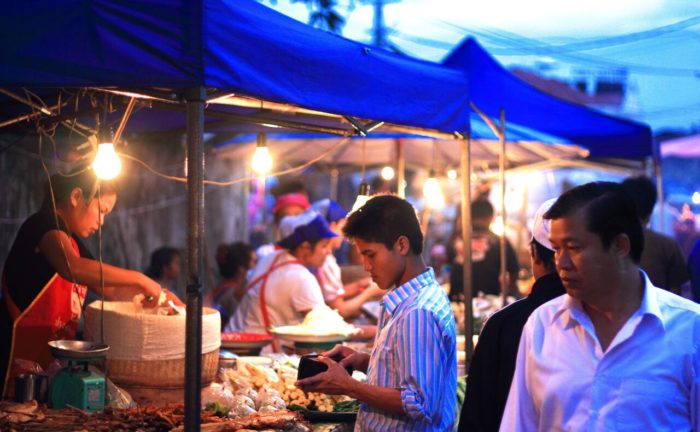
Women’s invisible burden
The struggle for dignified and meaningful livelihoods in the informal sector in Lao PDR
Key Facts:
- Women represent more than 90 per cent of vendors in fresh food markets across the country.
- Market vendors earn 100,000-500,000 LAK (12 – 62 USD) on a daily average.
- Women market vendors in Vientiane have faced exorbitant rent and electricity cost increases.
- Women are poorly represented in decision-making bodies in business life.
- Women take up to four times more house chores and care work than men.
- Women are heavily represented in the 71 percent of the population reliant on subsistence agriculture.
Every morning, Mrs. Khong rises before dawn to prepare the morning meal and tidy her modest home for her family in Vientiane, the capital of Lao PDR. As her husband and young children awake, she already has several hours of work behind her and hurries to the local market to set up her small, road-side stall selling fresh fruit and snacks, in time to catch the morning rush of customers. Mrs. Khong is worried. There have been rumours that the market will be developed and that she will be forced out or won’t be able to pay the increased rent for her stall. Her husband earns a small income labouring and without her small business, she and her husband will struggle to keep their girls in school and put food on the table.
As a hard-working entrepreneur, Mrs. Khong is already making plans for the worst. “If the rent prices go up again, many of us can’t stay here. We will have to go to another market and start over. I feel like the market authorities don’t care about us,” Mrs. Khong says.
Mrs. Khong is not alone in her struggle and anxiety for a dignified and stable livelihood to support her family. Millions of women around the world are still struggling with the economic and social dimensions of gender inequality. Put simply, women are not equal in the workplace and are still fighting for their equal rights to a good job, fair pay, safe working conditions, an adequate pension in old age, healthcare and safe water.
The small-scale business sector in Vientiane is dominated by Lao women like Mrs. Khong, who represent more than 90 per cent of vendors in fresh food markets across the country. The women of Laos are subject to the same economic and social inequalities faced by millions of female market-vendors around the world who tenuously eke out a living in the informal business sector.
According to the Gender Resource Information and Development Centre under Lao Women’s Union, a lack of education and economic opportunities, and limited access to resources drive women into the informal sector and small-scale enterprises. The vast majority of these women fall into one or more vulnerable groups: ethnic minorities, informal workers, poor, educated at a low level, living with disabilities or residing in remote areas. These women encounter even greater obstacles to decent jobs, services and other fundamentals of well-being.
A recent push by the Government of Lao PDR to improve women’s economic position is evident in its National Strategy for the Advancement of Women, aimed at promoting women’s small and medium enterprises and economic leadership, increasing women’s participation in development planning and improving their access to services. Other recent advances include women’s growing participation in the labour market. However, many economic and social challenges remain for Lao women. Large differences are still evident in the development levels of men and women, and among women. Whether this push towards gender-sensitive policy makes a difference for Mrs. Khong and the millions of women working in the informal sector in Lao PDR remains to be seen.
A recently published report by UN Women titled, Progress of the World’s Women 2015-2016: Transforming Economies, Realizing Rights, (click here for summary in Lao) investigates the current status of gender equality across the world and makes recommendations for actions to address the gaps in order to achieve sustainable development goals. In addition, this report focuses on the global economic and social dimensions of gender equality. Complementing these findings is a recent study on the Situation of Women Market Vendors in Vientiane Capital, (click here for Lao version) a situational analysis on female market vendors, the first of its kind in Lao PDR.
Speaking at the Vientiane launch of the reports this week, Dr. Miwa Kato, Regional Director, UN Women Regional Office for Asia and the Pacific explained, “The reports look particularly at the ‘invisible’ economy of unpaid care and domestic work. This invisible contribution is acknowledged to anchor all economies and societies. It is women and girls who carry its weight.”
The study on women market vendors in Vientiane found that despite women representing the vast majority (over 90 per cent) of vendors in fresh food markets across the country, their r
Comments RSS Feed